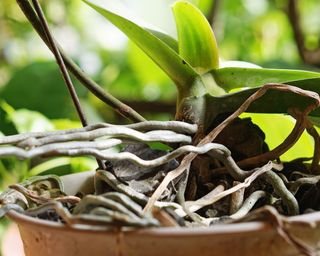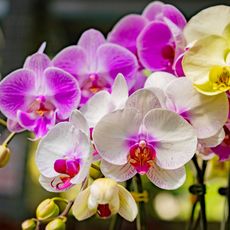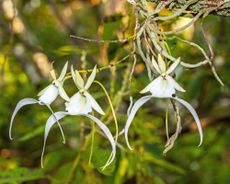How Often To Water Orchids – The Definitive Guide
Orchids are too often victims of under and over-watering. Discover how often popular species need to be watered and the key signs to look for.


Confused about how often to water orchids? You're not alone – it is a common concern for owners of these stunning houseplants.
While orchid care comes easy to some growers, many find it challenging to meet the plants' unique needs.
Learning how to water orchids is a big part of the learning curve. However, infrequent or excessive watering is the biggest cause of plant death.
Don't forget that orchid fertilizing is an important part of plant care and should be done at the time of watering.

How Often To Water Orchids
Orchids generally need water once a week during the winter and twice during warmer weather. However, this is impacted by the ambient temperature, humidity levels, and chosen growing medium. Different types of orchids also have different needs.
In general, orchids with pseudobulbs, thick fleshy roots, or big leaves need watering less often than those with thin leaves or roots.
Pseudobulb orchid species, such as the Oncidium orchid, Cattleya orchid, and Dendrobrium orchid, have an advantage in that their pseudobulbs retain moisture. They should be allowed to dry out a little before being watered.
Gardening tips, videos, info and more delivered right to your inbox!
Sign up for the Gardening Know How newsletter today and receive a free download of our most popular eBook "How to Grow Delicious Tomatoes."
Meanwhile, species without pseudobulbs, such as the Vanda orchid and Paphiopedilum orchid, may need watering more frequently.
The ever-popular Phalaenopsis orchid has both thick roots and big leaves that reduce watering frequency. However, as it has no water storage organs, it should not be allowed to completely dry out.
While most orchids operate on a cycle of wet and dry, some prefer almost constant moisture, such as the Cymbidium orchid and monkey orchid.
Never ignore your orchids' watering needs for longer than 2-3 weeks.

Signs An Orchid Needs Watering
If the orchid potting mix has dried out, then it's time to water. You can feel for moisture by pushing your finger down into the mix about one inch deep. Also look for visual clues, such as condensation on the inner plastic pot.
However, the best way to learn how often to water orchids is to gain an understanding of root health.
Orchid roots are surrounded by a thin membrane called velamen. It not only soaks up lots of water rapidly, but also adheres to rough surfaces and facilitates the uptake of other nutrients.
If the velamen is dry and silvery, the orchid is likely dry and in need of a drink. Newly watered velamen should be green or mottled.
Black or dark brown roots with signs of rot usually mean the plant has been overwatered.
Many orchids are epiphyte plants that attach themselves to trees and get their water from rain or water vapor in the air. They aren’t used to drowning in water, which can lead to rot and the death of the plant.

How The Growing Medium Affects Watering
The orchid potting medium will also impact how often you should water. If a medium retains water well – such as pine bark nuggets or sphagnum moss – the orchid needs water less often. If, however, a less water-retentive medium is used – such as charcoal or clay pellets – the plant will need more frequent irrigation.
That said, a standard medium for orchids should contain a mix of fir bark, fern fiber, perlite, gravel and sphagnum moss.
Mounted orchids need more frequent waterings than those grown in containers.
Should I Water My Orchid More When It Is Flowering?
Water your orchid more often when it is nearing bud break or when it is in bloom. There is a fine line here though. Keep an eye on the plant’s roots and the potting medium to monitor for moisture. If the medium is drying out go ahead and water the plant, otherwise leave it for a while.

Amy Grant has been gardening for 30 years and writing for 15. A professional chef and caterer, Amy's area of expertise is culinary gardening.
- Melanie GriffithsSenior Editor
-
 7 Best Trailing Plants For Hanging Baskets – Create A Delightful Summer Display
7 Best Trailing Plants For Hanging Baskets – Create A Delightful Summer DisplayHanging baskets are a staple of the summer patio. Use these plants to create trailing masterpieces that add beauty and elegance to your outdoor space.
By Melanie Griffiths
-
 Old-Fashioned Flowers And Plants That Will Transport You To Another Time
Old-Fashioned Flowers And Plants That Will Transport You To Another TimeFancy bringing some old world beauty and elegance to your space? These nine old-fashioned flowers can help you add a touch of nostalgia and romance
By Mary Ellen Ellis
-
 How Long Do Orchids Live? And How To Extend Their Lifespan
How Long Do Orchids Live? And How To Extend Their LifespanWhen well cared for, orchids can prove a long-term investment. Discover the lifespan of popular species, and how to prolong your enjoyment of your plant.
By Mary Ellen Ellis
-
 Orchid Leaves Turning Yellow: Common Causes And Remedies
Orchid Leaves Turning Yellow: Common Causes And RemediesYellow orchid leaves are a frequent cause of concern for indoor gardeners. Discover how to diagnose the issue, and restore your plant to full health.
By Melanie Griffiths
-
 How Often Do Orchids Bloom? And How To Encourage More Frequent Flowers
How Often Do Orchids Bloom? And How To Encourage More Frequent FlowersIf you're impatiently waiting for your orchid to rebloom, it pays to understand its natural flowering cycle. Discover common bloom times, and how to increase frequency.
By Mary Ellen Ellis
-
 Monkey Orchid Care: How To Grow This Fascinating Species
Monkey Orchid Care: How To Grow This Fascinating SpeciesThe monkey orchid (Dracula simia) bears a remarkable resemblance to its namesake and, with a little know-how, can be successfully grown as a houseplant.
By Bonnie L. Grant
-
 26 Different Types Of Orchids – With Pictures & Information
26 Different Types Of Orchids – With Pictures & InformationDiscover stunning orchid types to grow in your home and garden – from easy beginner varieties to rare and exotic species that are the preserve of experts.
By Melanie Griffiths
-
 Orchid Care: How To Grow Happy, Healthy Plants Indoors
Orchid Care: How To Grow Happy, Healthy Plants IndoorsGrowing orchids as houseplants is such a rewarding hobby. Learn their unique care needs to keep plants thriving and bursting with flowers.
By Melanie Griffiths
-
 Orchid Buds Falling Off: How To Prevent Orchid Bud Blast
Orchid Buds Falling Off: How To Prevent Orchid Bud BlastIf your orchid's buds fall off before they have a chance to bloom, your plant has bud blast. Learn the common causes and how to remedy the situation so you can enjoy your orchid flowers for as long as possible.
By Melanie Griffiths
-
 Ghost Orchid: How To Grow This Rare & Beautiful Flower
Ghost Orchid: How To Grow This Rare & Beautiful FlowerThe native ghost orchid – or Dendrophylax lindenii – is the most coveted species among home growers, but it is not for the faint-hearted. Discover how to get started growing these rare, enchanting flowers.
By Melanie Griffiths